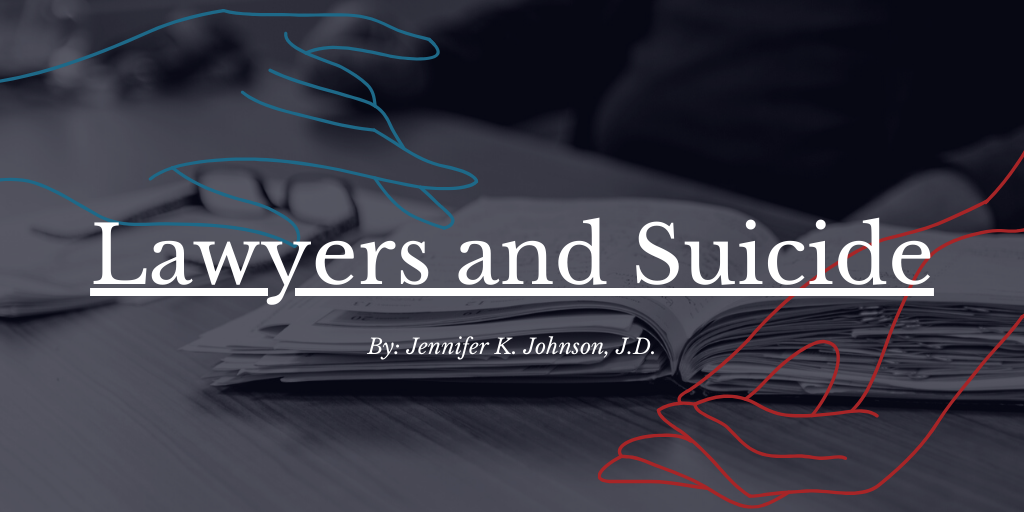By: Jennifer K. Johnson, J.D.
Lawyers in America have disproportionately high rates of depression and substance use disorder compared to the general population.[1] A 2016 study by the Hazelden Betty Ford Foundation and the American Bar Association (ABA) Commission on Lawyer Assistance Programs found that 20.6 percent of working lawyers screened positive for harmful and potentially problematic drinking, 28 percent reported depression, 19 percent reported anxiety and 23 percent were experiencing stress.[2] Mental disorders and substance use are well-known risk factors for suicide.[3] In the legal profession, the prevalence of both conditions portends an increased danger of suicide for lawyers.[4]
This risk takes on added urgency when we consider recent statistics on suicide in the United States. In the last two decades, the suicide rate has increased significantly. In 2000, the rate was 10.4 per 100,000 people. By 2016, it was 13.5 per 100,000—an increase of about 30 percent.[5] According to the Centers for Disease Control and Prevention, well over 47,000 people died by suicide in 2017.[6]
Why Lawyers Are at Risk
While addiction and mental health issues can affect anyone, lawyers in all practice areas may be particularly vulnerable because of the nature of the work. Common contributing factors to psychological distress among lawyers are high internal and external expectations, a sense of dissatisfaction with the profession, long hours, stressful time constraints, and the general responsibility that comes with having a law license.[7] Many of these stressors exist in other professions, but they are exacerbated in law by the profession’s uniquely adversarial system. The search for the truth in our system of justice is one where the two opposing parties compete against each other before a neutral fact-finder who determines the outcome.
For lawyers working in the criminal justice system, the adversarial culture is especially intense and concentrated. Public defenders and district attorneys are in court day after day handling serious, weighty cases in a fast-paced, demanding environment. They have high caseloads and very few behavioral health resources. They are confronted with traumatic stories of human-induced violence that lawyers in other practice areas may not ever encounter. For the players in this system, the unique combination of risk factors sets the stage for dysfunction that can manifest in compassion fatigue, burnout, substance use, relationship problems, physical health problems, and mental health issues. Sometimes, it leads to suicide.
Why Don’t Lawyers Seek Help?
In the legal profession, there are perceived barriers that prevent early intervention when a lawyer may be on the road to crisis. Lawyers and judges are held to a high standard of conduct and usually strive to maintain outside appearances. As a society, we still struggle with the stigma of mental illness and the outdated notion that mental impairment is a sign of weakness or moral failing. In the high-pressure legal world, fear of disclosure and the consequences that might flow from disclosure are very real. The culture of the profession has not traditionally been one to encourage treatment.
The good news is that the profession is changing. In the criminal justice system, with the proliferation of problem-solving courts and a focus on therapeutic jurisprudence, we see how justice can also be achieved in a non-adversarial forum. Collaborative courts now exist side by side with traditional trial courts, affording lawyers opportunities to practice law in a way that promotes the mental health of the entire system. Civil firms have moved ahead, opening their boardrooms to wellness programs, cutting back on the afternoon drinking forays, and providing attorneys with mindfulness support.
In the wake of the shocking numbers revealed in the 2016 study[8] on mental health and substance use in the legal profession, the ABA has taken action. In addition to creating the National Task Force on Lawyer Well-Being in 2017,[9] the ABA has called on legal employers to commit to making lawyer wellness a priority. To date, nearly 200 law firms, corporations, and law schools have signed onto the ABA’s Well-Being Pledge.
Resources
If you or someone you know is experiencing a mental health crisis, you can reach the National Suicide Prevention Lifeline by phone at 1-800-273-TALK (8255) or via webchat using Lifeline Chat.
Like what you’ve read? Sign up to receive the monthly GAINS eNews!
[1] Patrick R. Krill, Ryan Johnson, and Linda Albert, “The Prevalence of Substance Use and Other Mental Health Concerns Among American Attorneys,” Journal of Addiction Medicine 10, 1 (2016): 46-52, https://doi.org/10.1097/ADM.0000000000000182.
[2] Patrick R. Krill, Ryan Johnson, and Linda Albert, “The Prevalence of Substance Use and Other Mental Health Concerns Among American Attorneys,” Journal of Addiction Medicine 10, 1 (2016): 46-52, https://doi.org/10.1097/ADM.0000000000000182; Jerome M. Organ, David B. Jaffe, and Katherine M. Bender, “Suffering in Silence: The Survey of Law Student Well-Being and the Reluctance of Law Students to Seek Help for Substance Use and Mental Health Concerns,” Journal of Legal Education 66, 1 (2016): 116–56, https://doi.org/10.1097/ADM.0000000000000182.
[3] U.S. Department of Health and Human Services. “Does alcohol and other drug abuse increase the risk for suicide?” https://www.hhs.gov/answers/mental-health-and-substance-abuse/does-alcohol-increase-risk-of-suicide/index.html
[4] Patrick R. Krill, Ryan Johnson, and Linda Albert, “The Prevalence of Substance Use and Other Mental Health Concerns Among American Attorneys,” Journal of Addiction Medicine 10, 1 (2016): 46-52, https://doi.org/10.1097/ADM.0000000000000182; Jeena Cho, “Attorney Suicide: What Every Lawyer Needs to Know,” (web page) American Bar Association Journal, last modified January 1, 2019: https://www.abajournal.com/magazine/article/attorney_suicide_what_every_lawyer_needs_to_know.
[5] Holly Hedegaard, Sally C. Curtin, and Margaret Warner, Suicide Rates in the United States Continue to Increase NCHS Data Brief 309, Hyattsville: Center for Disease Control National Center for Health Statistics, 2018, https://www.cdc.gov/nchs/data/databriefs/db309.pdf.
[6] Kenneth D. Kochanek, Sherry L. Murphy, Jiaquan Xu, and Elizabeth Arias. “Deaths: Final Data for 2017.” National Vital Statistics Reports 68, 9 (2019), https://www.cdc.gov/nchs/data/nvsr/nvsr68/nvsr68_09-508.pdf.
[7] Lee Norton, Jennifer Johnson, and George Woods, “Burnout and Compassion Fatigue: What Lawyers Need to Know,” University of Missouri-Kansas Law Review 84:4 (2016): 977-1002.
[8] Patrick R. Krill, Ryan Johnson, and Linda Albert, “The Prevalence of Substance Use and Other Mental Health Concerns Among American Attorneys,” Journal of Addiction Medicine 10, 1 (2016): 46-52, https://doi.org/10.1097/ADM.0000000000000182.
[9] National Task Force on Lawyer Well-Being was conceptualized and initiated by the ABA Commission on Lawyer Assistance Programs, the National Organization of Bar Counsel, and the Association of Professional Responsibility Lawyers.


